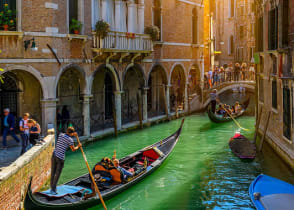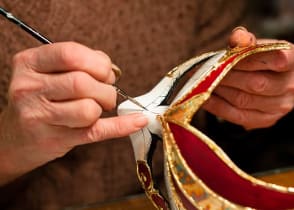10 Italian Arts & Crafts - How to See and Experience Them

Colorful artisan ceramic plates found in Southern Italy
Artisans use traditional techniques that turn craftwork into artistry and our list of the 10 Italian arts and crafts and how to see them immerses you in the culture, heritage, and beauty of Italy.
From colorful to creative, authentic to enticing, artisan crafts capture the essence of Italian heritage and carry the proud legacy of the past into the future. Whether eager to view the glint of Murano glass or enticed by the elegant curve of a traditional shoe, Italian craftsmanship is known for turning daily life into artistic expression.
Our list will help you explore Italy by providing ideas on how to discover the country and where you can find each historic craft for a new and exciting experience.
1. Murano Glass
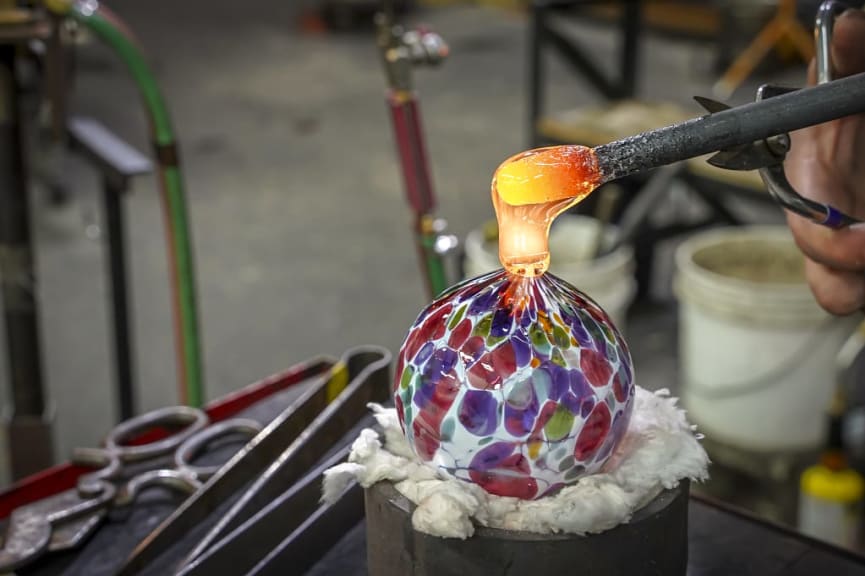
Beautiful glass ball being made by a glass blower
Murano glass is one of Italy’s most famous products, with a history that dates back nearly a millennium. Visitors flock to the Venetian Lagoon to visit the famed island that became a glass-production center after the Doge ordered all glassblowers off Venice's main island due to fears of fires from the kilns.
Murano glass blowers continue the traditions of artistic masters who brought fortune to the Venetian Lagoon and elevated their families' importance to the status of near-nobility. Some of the most influential brands of glass are still produced in the historic factories on Murano, such as Venini, Barovier and Toso, Pauly, and Seguso.
Showrooms across the island of Murano provide displays of artists' fascinating work, while the working studios allow visitors to see the stunning techniques of the artisan glass blowers in action. Your studio visit can also offer the chance for a hands-on workshop. You and your instructor can produce a small souvenir in the glass arts, such as a necklace, bracelet, or delicate mosaic complete with rainbow hues as you discover the right Venice vacation and tour for you. Embrace the floating city and its timeless wonders with our Venice travel guide.
Where to Visit: Murano (Venice)
2. Ceramics and Pottery

Ceramic vase being decorated by a local artisan in Caltagirone, Italy
Pottery and ceramics have a rich history that dates back over two millennia, to the Etruscans in Central and Northern Italy and the Phoenician and Greek settlers in the south and Sicily. Crafters continue to produce pots, jugs, and earthenware vessels in the style of their regional heritage, recreating the classic shapes and colors with traditional techniques, while meeting contemporary aesthetics.
When meeting different artisans, you can have the chance to shape your own piece after learning about the heritage of the trade on the Italian Peninsula and the particular history of the studio you are visiting. Your guide can walk you through making a bowl, plate, cup, or vase following the region's customary techniques.
It is easy to find small shops across Italy showcasing the ceramic or pottery craftsmanship for which an area is known, especially during a personalized Tuscany tour. For a more hands-on experience, you could enjoy a ceramics or pottery workshop to learn about the art, history, and heritage of the craft specific to each region and connected to the depths of Italian roots, from Tuscany to Basilicata, Abruzzo to the Amalfi Coast.
Where to Visit: Tuscany • Abruzzo • Calderone • Umbria • Basilicata • Amalfi Coast
3. Trompe l’Oeil Paintings

Trompe l’Oeil Painting in Sorrento, Italy
The illusion of three-dimensional objects in art adds unique layers of storytelling to paintings featured across Italy, with a small batch of artisans who continue to produce works in this field. Some painters create small murals and decorative doors, while others decorate plates and glassware.
Artists may also take commissions, using the technique to create three-dimensional still-life paintings in their patron’s home. The distinct quality of the painting and the focus on the aesthetic ensures each piece is unique, with details crafted to your personal preference.
For a more in-depth experience, you could opt to learn the technique by crafting a frame or ornament, forever cherishing the practical application of mixing shades and working with light and shadow for complexity in your future artwork. It is easy to embrace the grand tradition on a Rome vacation or when exploring Northern Italy.
Where to Visit: Rome • Pompeii • Brenta Canal • Mantua • Genova
4. Shoes
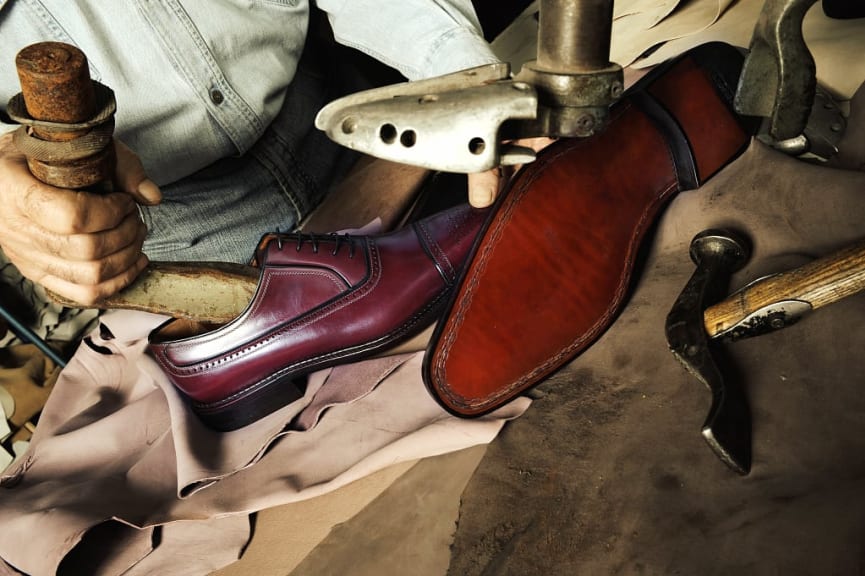
Italian cobbler making luxury leather shoes
Italian cobblers have always met the demands of their clientele with superior quality and refined taste. Cobblers in Italy continue to follow the traditions of their trade with hands-on experience that blends with modern technology. Time with a cobbler will provide insight into the process and history of Italian craftsmanship, including the ways shoemakers have mastered their skills over time.
The region of Campania is known for artisan crafts like cobbling, while the leather goods of Tuscany include the sensational art of making shoes. Artisan craftspeople in Lombardy highlight pride, quality, and individuality in work that focuses on the ways a particular aesthetic combines tradition and fashion-forward ideas in the industry.
By emphasizing quality and style, your shoemaking experience in Italy will bring you more knowledge of the industry in the country and can also provide you with a pair of luxury Italian shoes to take home. As crafting shoes is an intricate process that takes time to learn, let alone master, there are not many demonstrations that offer a hands-on experience.
If learning to cobble shoes is of interest to you, there are plenty of courses across Italy that offer insight into mastering the tradition, with each class taught by a local artisan. Various regions across the country host famous artisan cobblers who transform shoes into artwork, such as in Le Marche along “Shoe Valley,” as well as in Venice and Rome, where a resurgence is taking place.
Where to Visit: Le Marche • Florence • Campania • Tuscany
5. Textiles

Tailor working on a custom suit jacket
Learn more about how designers take inspiration from their surroundings during a textile tour and workshop that will introduce you to how weavers create stunning patterns with intricate attention to their craft. Textiles add to Italy’s history by showcasing unique garments representing the various eras of Italian culture and politics, and shifting economic policies.
Hand-woven pieces can include tablecloths and cushion covers, while pieces shaped with a loom grow into stunning clothes and tapestries. Visiting a studio for a day allows you to observe the artisans at work and participate in a beginners’ workshop. Studios across Italy offer courses that last up to six weeks, but can also provide the basics of making textiles with a three-day workshop that can inspire countless Italy vacation ideas.
Instead of a course in tapestries or weaving, you could opt to discover the rich history of textiles by visiting specific shops, warehouses, or factories known for producing elegant laces and fine suits. You can find hand-dyed patterns, sophisticated styles for cold weather, and antique looming dating back to the Renaissance.
Where to Visit: Emilia-Romagna • Surano • Basilicata • Valle d’Aosta • Solomeo • Veneto
6. Stained Glass
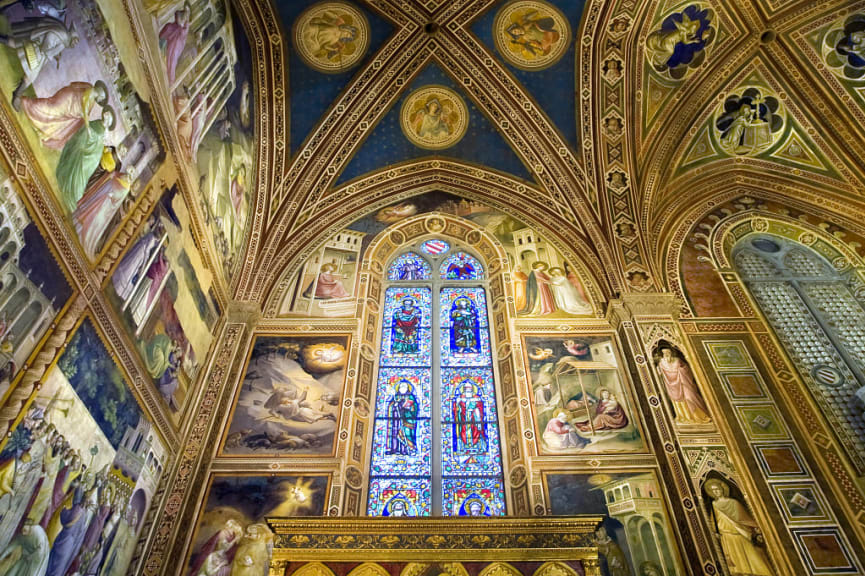
Stained glass windows of the Basilica of Santa Croce in Florence, Italy
The endless number of churches, basilicas, and cathedrals in Italy could very well inspire you to craft your own stained-glass windows. With traditions that date back to stories told by Pliny the Elder, Phoenician sailors discovered the technique by accident after a shipwreck. Romans were glazing glass into windows by the 1st century AD and began using blowing techniques to mold the glass. The oldest known examples of multiple pieces of colored glass in windows date back to St. Paul’s Monastery in England in 686 AD.
While a stained-glass workshop might be similar to a glass-blowing demonstration, the techniques and results are far different. Artisan studios across Italy produce hand-painted stained-glass windows for cathedrals and monuments around the world by blending chemistry and art to shape the colorful glass.
A guided visit through any workshop will highlight how a stained-glass artisan uses old and new techniques to create the classic look of radiant decorations with masterful alchemy. A day’s workshop and even longer courses can elaborate on the unique methods used to paint glass and produce the colorful works that decorate the towns and cities across Italy, including the elegant marvels of Milan.
Where to Visit: Mondaino • Milan • Florence • Puglia
7. Jewelry
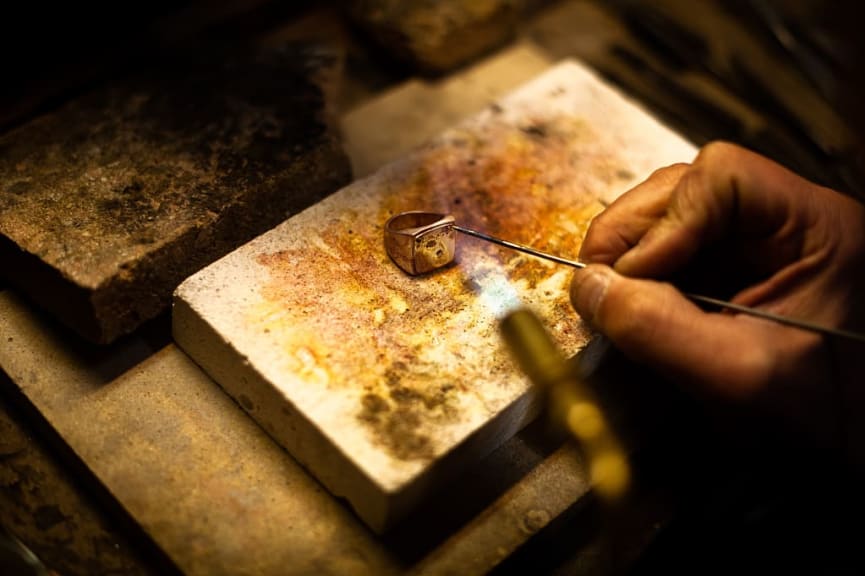
Artisan jeweler making a silver ring in Florence, Italy
Jewelry in Italy is inspired by the microclimates that support everything from a huge coral reef to the splendors of the Mediterranean Sea, gold shaped by the hills of Umbria to personalized designs in Abruzzo. The craft dates back beyond ancient Rome, with functions touching on ancient Greeks and Etruscans who settled on the peninsula.
Italy and high fashion go hand in hand, which is why jewelry workshops that are offered around the peninsula provide fabulous insight into the design process. One of the most notable costume jewelers in the world is Florentine designer Angela Caputi, who combines modern style with traditional handmade craftsmanship to produce fashion-forward statements in a bedazzling showroom. The workshop is in the artisan district of Oltrarno.
Artisan jewelers allow the value of their art to shine through superb craftsmanship and the unique connection to ancient regional history. A visit to a workshop and jewelry design studios in Italy provides access to the framework of past productions as they map size, color, and the number of beads per piece to create one-of-a-kind selections perfect for family heirlooms or when enjoying a romantic Italy tour for couples.
The intricacies of jewelry make a one-day workshop challenging, but if you wish to indulge in an intensive, hands-on course, there are two-, three-, and even five-day courses, along with classes that last up to three months on a single student-to-teacher ratio, providing the best techniques, tools, and materials Italy has to offer.
Where to Visit: Florence • Sardinia • Abruzzo • Umbria • Sciacca
8. Paper

Florentine marbled paper
The importance of paper remains an integral part of Italy in a variety of regions. Paper has an illustrious and overlooked history that dates back to second-century China and did not reach Europe until after the Crusades in 1085, eventually leading to the invention of the printing press in 1493. The art of papier mâché in Italy dates back to the 17th century.
Small, family-run workshops continue to stick with their heritage, making marbled paper, while other artisans use papermaking for such crafts as making masks. Customary techniques remain popular, with artisans crafting many unique items, from jewelry boxes to shape handbags and exquisite journals.
Paper workshops in Italy provide a hands-on experience dedicated to the art of restoring antique prints and books with classes that take you behind the scenes of making paper. Your instructor will share traditional techniques to conserve and restore old prints developed over a half-millennium ago. You can also learn about the different methods of making fine paper, while listening to fascinating anecdotes about the history of the trade as you travel between Venice, Florence, Rome, and Sorrento.
Where to Visit: Tuscany • Venice • Fabriano
9. Woodwork

Luthier, violin maker, in Cremona, Italy
The craftspeople of Italy are known for their skills and diligence, demonstrated through remarkable wood carvings. Crafted throughout the various regions across the country, diverse heritage is on display, from religious artwork to cabinet making, daily utensils to finely-grained bowls.
Crafters display different techniques and woodcarving methods passed down through the centuries. Artisan woodworkers shave away bark to transform their tools that have been taken from the landscape into art.
Ornamentation connects with tradition, while also providing a touch of each aristan’s unique aesthetic. Handmade cupboards, dressers, craft chests, chopping boards, and ceremonial masks are a delight to explore. Other artisans may hone their techniques to make each piece shine with color, grain pattern, and a unique luster, such as the famous Stradivarius violin.
Where to Visit: Sardinia • Molise • Milan • Liguria • Basilicata
10. Mosaics
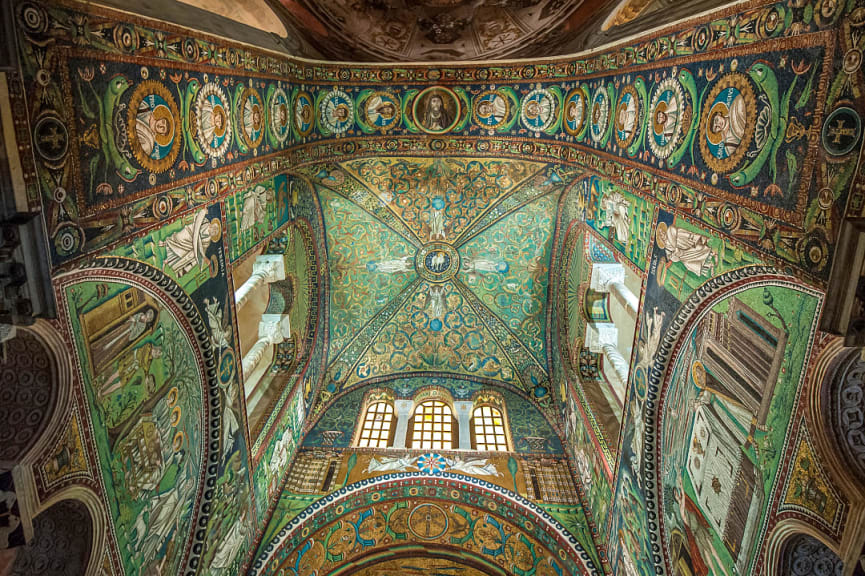
Mosaics of Basilica of San Vitale in Ravenna, Italy
The ancient tradition of mosaics has been part of the artistic framework of the Italian peninsula since the Greeks arrived in the eighth century BC, continuing into the Roman and Byzantine empires. The custom of crafting fantastic images formed by pieces of broken stone or glass has continued through the ages, with artists crafting gorgeous, elaborate, and captivating works by hand.
Mosaics showcase the intersection of ancient art and contemporary aesthetic, while also representing finer details of work, like patience and an eye for intricate detail. Different regions in Italy carry on the unique aesthetics from the various cultures that pursued mosaic arts.
The crafts of Emilia-Romagna display small pieces of broken stone or metals to create the antique medium, offering a revitalized, fresh look. The craft takes inspiration from the past, with traditions highlighted by gilded, religious art that adorns church facades and naves in Ravenna.
For the best introduction to mosaics in Italy, you can uncover the exceptional art form preserved in idyllic churches or by partaking in a mosaic workshop. This could take more than one day as you learn how to use the tools, place the pieces, and let the work dry to take a piece inspired by history home with you. Visit a studio for a private lesson or find elegant collections. A private tour can allow you to experience the preserved history of Italy’s woodworking mastery.
Where to Visit: Ravenna • Rome • Sienna • Palermo
Experience the Best of Italian Arts and Crafts

Murano glass in Venice, Italy
Arts and crafts in Italy are a source of innovation that embody a historic spirit. Whether on a romantic getaway or a culinary adventure, an Italy travel specialist has local knowledge and the ability to personalize your tour to your tastes.
Find more inspiration for your perfect vacation with our Italy travel guide or when exploring our Italy tours and vacations.
Life-Enriching Travel Designed Just for You
- 1
Trips curated by the world’s top destination experts
- 2
Concierge-level service leading up to and during your trip
- 3
Unique, exclusive experiences and insider access
